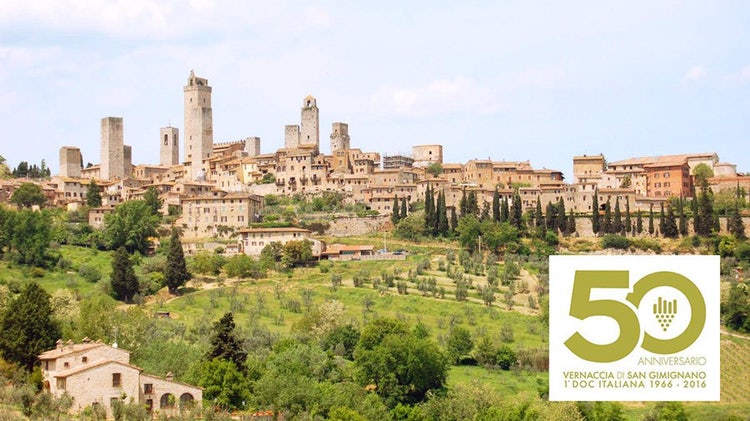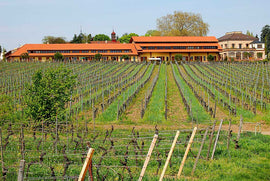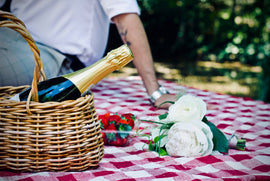Italian Wine Club ~ La Dolce Vite
January 2019
Elio Longobardi, Italian Wine Specialist
PlumpJack Wine & Spirits – Noe Valley
Sono Montenidoli, Carato, Vernaccia di San Gimignano DOCG 2013
Elisabetta Fagiuoli moved to this part of Tuscany with her husband Sergio Muratori in 1965. Sergio is a poet, a writer, and taught children with special needs in Genoa. He and Elisabetta were looking for a place to educate nine of those children who lived with them away from the stress of the city. They found this estate, Montenidoli (the mountain of many nests), of 200 hectares or about 500 acres of forest with 24 hectares planted with vines and some with olive trees. The property was in poor shape at the time they took it over, with the vines neglected and the olive trees with overgrown suckers. While Sergio dedicated himself to the care of the children Elisabetta immediately began reviving their land. Coming from a family that had been making wine and olive oil since the 1700’s in the Valpolicella area and growing up among the vines and olive trees, it was natural for Elisabetta to return to doing what was already in her bloodstream.
The land at Montenidoli is among the most diverse and rich. It goes from Quaternary soil (65 million years ago) on the slopes, where the calcareous sediments with an abundance of fossils and seashells were left by the Ligurian Sea, to Triassic soil (250 million years ago) on top, the oldest in Tuscany and the only Triassic soil planted to vine. Here the soil is red, rich with iron and other minerals. To have those two very diverse environments of terrain was a sign for Elisabetta of how unique and special their place was.
Elisabetta replanted the vineyards with indigenous Tuscan varietals: Vernaccia, the grape of San Gimignano; Trebbiano Gentile; Malvasia Bianca; Sangiovese; Canaiuolo; and Colorino. Her strong will, hard work, and passion are producing wines that are amazingly unique. Take the Vernaccia for instance; before tasting Elisabetta’s Vernaccia I had never been impressed by this varietal. The wines were too bland, too acidic, and unimpressive, with nothing much else to recommend them. The first time that I tasted her Vernaccia a few years ago was a revelation! I fell instantly in love with her wines.
Three Vernacce are bottled at Montenidoli: Tradizionale, Fiore, and Carato. The first two are aged only in stainless steel. Her Templare is a white blend made with Vernaccia, Trebbiano, and Malvasia. She does a rosato made with the Canaiuolo grape, what Elisabetta calls “the poor person’s champagne,” a Chianti Colli Senesi, and two 100% Sangiovese.
I had the pleasure to meet Elisabetta several times during the year and the privilege to visit her with my wife at Montenidoli last summer. If I wasn’t already convinced enough about her work, to be there in that magical place chased away any doubts. The estate is not one of those magazine types of winery you can find too often in Tuscany or Napa: no fancy designer architecture, overly manicured garden, or infinity pool. No non-sense. The cellar is clean and efficient and the tasting room is homey and familiar. The only decorations are big chunks of rock with amazing fossils and abstract forms of minerals that were extracted during the work in the vineyards. We visited the vineyards aboard a funky jeep passing through the shade of the massive forest that covers most of the property. There, at night, foxes, wild boar, porcupines, and other animals roam freely. After a long trip of bumps and dips we reached a clearance that opens toward the vineyards in which the Vernaccia is planted on the slopes of Quaternary Pleistocene soil. Elisabetta says that the ancient seabed minerals are what give her wine that particular aroma and bouquet. The red soil indicates where Sangiovese and other red varietals are planted. Especially for Sangiovese, the rich high iron compound instills the grape with intensity and body.
Back at the tasting room Elisabetta was waiting for us with a plate of salumi and cheeses and a line of bottles to taste. She told us that she’s not forgotten the main reason why she and Sergio moved there: caring for the people with special needs, comforting them, and offering a place of solace and peace. Sergio, the Patriarch as all knew him, passed away in 2012, but Elisabetta has kept his vision alive, creating a non-profit foundation named after Sergio. Most of the profits from the wine and olive oil sales go to the foundation which uses them to fix old farm houses on the property in which young and old persons in need are housed. They can stay there a month at a time to participate in and enjoy the life of the farm. Some have decided stay and there are now persons who live there with their own families participating in this labor of love.
It was late in the evening. The July sun was setting behind Montenidoli sending a golden glow to the east and the town of San Gimignano and her towers, resembling a Renaissance painting. We said goodbye to Elisabetta and her crew with a great feeling of lightness in our hearts. The magical spirit of the place and the incomparable quality of her wines did it for us, and I bet would for you too if decide to visit Montenidoli.
The Vernaccia di San Gimignano Carato spends twelve months in small oak barrels. It’s a white with a red wine soul. Carato is in the same tier of white wines like a great Meursault or a Chateau Smith-Haut-Lafitte. A color of golden straw, a nose rich with cedar and other wood spices, citrus and waxy honey notes, and a fresh saline minerality makes for a wine worth a long ageing as well. It is a wine for savoring that pairs best with rich dishes like grilled swordfish, lobster, wild mushroom risotto, Parmigiano and Stilton cheeses.
Poderi Sanguineto I & II, Vino Nobile di Montepulciano DOCG 2014
The youngest of nine children, Dora began working side by side with her father at the age of 18 in 1968, helping him with the many duties the land and the animals required. The vineyards are only a small part of the estate, 5 hectares of the 38 that make up the property. Until 1997 they were selling their wine only in bulk but then Dora discovered some bottles that her father had saved from the 70’s. When she tasted them she discovered that the wine not only held up to the passing time but also was very good and that convinced her to start bottling.
Similar to Elisabetta, Dora has the same approach in the vineyards and in the cellar; minimum intervention, maniacal attention to details, and letting the fruit tell its own story. They farm organically and biodynamically without the need of certification. Their sincerity and honesty is all that is needed. Dora Forsoni runs the Sanguineto estate with her life and business partner, Patrizia Castiglioni. Dora does all the viticulture work alone, taking care of 100% of the vine maintenance: she works the soil, she prunes and ties every vine of her 3.5 hectare estate by herself. The only time someone else ever steps foot in the vines is during the harvest when a small team of friends helps out.
Dora’s farm is now 50 hectares (125 acres) with only about 10% planted in vines. The rest is in grain, sunflowers, open fields and woodlands. The vineyards are at about 300 meters altitude on a northeast-facing slope above the Val di Chiana. Their proximity to three lakes (Montepulciano, Chiusi and Trasimeno) mitigates both cold and heat. The soil is red, ancient layers going back to the Pleistocene era of clay, stones and marine sediment. The main actor in the vineyard is Prugnolo Gentile, a strain of Sangiovese, planted only in Montepulciano. Small percentages of Canaiolo, Nero Toscano (another strain of Sangiovese, one of the 110 Sangiovese strains!), and Mammolo are used by Dora because she says they help Prugnolo Gentile to develop more layers and depth. Besides Rosso di Montepulciano, Vino Nobile, and Vino Nobile Riserva she makes a white wine, Bianco Toscano, in which Malvasia Verde, Malvasia Bianco, Biancame, Trebbiano and Grechetto are used.
Dora’s father planted most of the vines on the estate in 1963. "He taught me that you make good wine by working well in the vineyard. To work in harmony with the vines, to listen to them to take care of them. To make a good broth, you need a good chicken!" The vines are all selection massale and franc de pied due to a technique that Dora learned from her father in which she allows a shoot to come off from the base of the vine that eventually caps off the old stump and lets the new shoot take over as the producing vine.
The bottle that you have in your hand is the Vino Nobile 2014. The juice after pressing is left to ferment with indigenous yeasts in cement vats and then transferred to big Slavonia oak barrels (botti) for two years before being bottled and released to the consumers. The color in the glass is a warm garnet with orange brick hues. The olfactory analysis shows balsamic notes of brandied cherry, fresh hearth, and damp forest floor. The tasting brings a clean acidity with a mouth filling warmth. There is a great balance between fruit and minerality and a very long finish.
I know it is not for everyone, but one of the best pairings is with braised rabbit with porcini mushroom. Or drink it with Pappardelle sulla lepre, Tuscan bread soup, or any other hearty food.
Tortelli di patate alla toscana
This traditional Tuscan recipe is typical of the provinces of Firenze and Prato. The tortello is a big ravioli stuffed only with a potato mix without any meat.
It is served either with meat sauce (duck ragu’ is recommended), or with butter, sage and Parmigiano cheese. It pairs well with the two wines of this month. It’s better with the Vernaccia di San Gimignano if you prefer meatless sauce, otherwise with the Vino Nobile. In any case I’m sure this dish, and the wines, will make you happy.
Ingredients (serves 6)
- 400gr flour 00 (double zero)
- 50gr semolina flour
- 6 eggs
- 1kg potatoes (Russets or Yukon Gold)
- ½ butter
- 3 tbsp. Parmigiano cheese
- 1 tsp. freshly grated nutmeg
- Salt & pepper
Directions
- On a clean surface make a mound with the flour and semolina
- Create a hollow space in the middle of the flour and crack inside 4 eggs
- Mix the compound until the dough doesn’t get smooth and elastic
- Let rest for half hour covered by a humid dish towel
- In a pot filled with cold water add the potatoes and bring to boil until cooked
- Peel the potatoes and press them through a ricer
- Add 2 eggs, butter, parmigiano, nutmeg, salt & pepper to the potatoes and mix together
- Set the filling aside
- Get the pasta dough and cut it in two pieces
- Using a rolling pin roll the dough until you get a smooth sheet, thin but enough strong to stretch
- Roll the other sheet of pasta dough in the same way and set aside being careful that it doesn’t stick together
- Make small balls, about ½ inch big, with the potatoes stuffing and set on the pasta sheet on the table at 2 inch distance from each other filling all the sheet
- Delicately set the other pasta sheet on top of the other one
- With your fingers press gently around each filling to get rid of any air
- When all the stuffings are properly pressed and using a ravioli cutting wheel cut a square of dough with the filling in the center separating each tortello
- Bring a pot of water to boil and cook the tortelli
- It will take not long time, as soon they start to float you should drain them and dress with your favorite sauce
Cover Photo via Discover Tuscany





